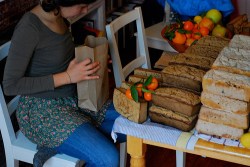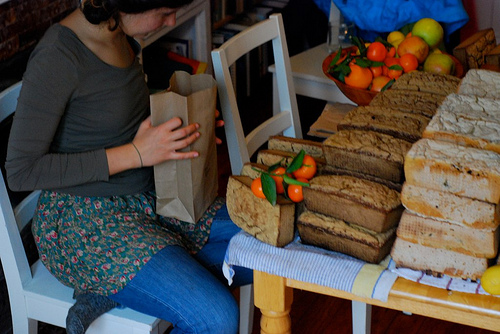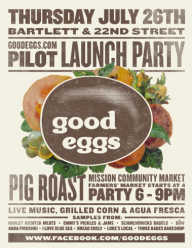
Fulfilling orders at Bread SRSLY.
When Sadie Scheffer decided to start her own vegan, gluten-free baking company, the logistics were not her top priority. Like many small food companies without retail spaces, she started Bread SRSLY by delivering her breads and muffins on a bike, using a makeshift online ordering system through email and Etsy, and taking cash on delivery. Scheffer’s system worked when she was fielding a few orders at a time, but when it came time to scale up, it was less than ideal.
Enter Good Eggs, a San Francisco-based startup that provides online tools for small and sustainable food producers. Now Scheffer’s orders come through the Good Eggs online platform, and on top of taking orders from house to house, she now also drops off a lot of product at once at community pickup spots arranged by the company. She sells three times as many loaves of bread as she did before Good Eggs. Scheffer admits that she’s had trouble keeping up with orders, but adds: “That’s the fun part, the scary part, and the only way I’m going to grow.”
When Good Eggs was founded in the summer of 2011, co-founders Rob Spiro and Alon Salant knew they wanted to build “a product and company to serve and grow local food systems,” even if they didn’t know what it would look like. But Spiro and Salant are no amateurs: Spiro is an original co-founder of Aardvark, which sold to Google in 2010 for $50 million, and Salant is a co-founder of a software design company called Carbon Five.
The pair quickly set out to figure out how they could use technology to boost the local food community. They discovered that most small food businesses were built by food people, not tech people, and they were often missing the software they needed for even the most basic operations. Many, they found, were spending time they could be baking, pickling, or curating filling out charts on Google Docs by hand and taking one-off email orders.
As Good Eggs handles the logistics, its vendors are watching sales climb. But whether or not Good Eggs — and other sites like it — will be able to truly enable small sustainable businesses to scale up over the long term (after the trend factor dies down) is an open question. The costs of labor and quality local ingredients are still incredibly high, and while Good Eggs offers some solutions, it’s not a one-stop shop for all local food producers’ problems.
“One of the earliest surprises was that the food industry is not one industry, it’s a dozen industries,” Spiro told me. “So the way that a baker is selling their fresh bread subscription through Good Eggs is totally different than the way a ranch is selling a quarter of a cow.”
Good Eggs launched its own site today, but for the past several months, the team has been building and running online storefronts on 40 San Francisco-based vendors’ websites. For 3 percent of each transaction, the Good Eggs team works closely with each to build a personalized online marketplace. “Our strategy is to align our incentives with the food producers,” says Spiro. The company also helps with marketing and promotion through what it hopes will become a large social media network of its own.
Take the Mission Community Market, a San Francisco nonprofit farmers market. It uses a Good Eggs platform to sell its Chef’s Market Box — a box of locally sourced ingredients with recipes from local chefs — but it also gets the company’s help writing and testing recipes, doing photo shoots, and handling delivery. It’s unclear which of these services will be available to Good Eggs clients in the future, but for Jeremy Shaw, executive director of Mission Community Market, it has made a world of difference. According to Shaw, “Without Good Eggs, the box wouldn’t be possible.”
Good Eggs is neither the first nor the last of the food-related startups scrambling to fill this space. Farmigo was one of the first of its kind when it was founded in 2008, and has since grown to provide 3,100 communities with farm-direct produce and CSA shares.
Plovgh similarly connects consumers with farmers, but gives buyers more flexibility and choice than a typical community-supported agriculture (CSA) box. The New York-based site, FarmersWeb, offers an ordering system for local produce in bulk at wholesale prices. And because customers have to pay in advance, farmers no longer have to track them down and demand payment. Sarah Teale of the Adirondack Grazers’ Cooperative says working with FarmersWeb is “like having an agent.” “I really don’t want to be the one calling the restaurant saying, ‘pay up,’” she adds.
Technology has long played a role in advancing the food system — but that has usually meant the use of chemicals, hardware, and machinery to improve efficiencies. Now, says Danielle Gould, the founder of the website Food+Tech Connect, “technology is becoming increasingly focused on information flow. The internet, software, and low-cost hardware are making it easy for everyone along the food supply chain to connect and coordinate logistics.”
Gould’s hope is that this shift will infuse more democracy into the food system — through access to more information and much more choice in the kinds of foods available.
After all, no matter how ethical and pasture-based the ranch or how local the grains, food companies are only sustainable so long as they can stay in business, and the hope is that new technology will also offer stability.
Of course the irony is that maintaining a diversity of online services isn’t easy. And with all tech bubbles, it’s likely that one or two companies providing infrastructure for local food will outlast the others. But with a growing consumer base for organic food, and farmers frequently faced with more supply than they can sell, these new distribution solutions likely have plenty of room to grow.
As Spiro sees it, “We have a theory that local food as a whole is poised to grow 10 times over. So all ships rise with the rising tide. Farmers markets, food producers, and customers should all win.” So who loses? “Safeway.”




